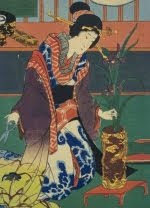Dooryard dock (Rumex longifolius), Japanese knotweed (Reynoutria japonica) and Geranium (Pelargonium).
Any material can be used in contemporary ikebana. In this blog post I have used plant materials found by the roadside. Presenting everyday materials in unexpected ways, showing their inherent beauty, is central to the philosophy of ikebana. It gives you a refreshing experience of seeing the well known as though you see it for the first time.
The back side of a leave often has a rich texture. Looking closer at the Dooryard dock I also found that the leaf edges has a beautiful curly finishing. This tiresome weed looks great when arranged to show it's best qualities. Showing the water surface in the arrangement has a cooling effect on hot summer days, and the green colour adds extra freshness.
Dooryard dock (Rumex longifolius), Japanese knotweed (Reynoutria japonica) and Geranium (Pelargonium).
Porcelain vase by Brigitte Schneider, Atelier Tokibana.
The technique I have used in this arrangement is similar to hanakubari techniques, using plant materials as visible fixture as well as main materials in the arrangement. "Hanakubari" consists of two Japanese words meaning a flower holder. It's a popular category of contemporary Japanese flower arrangement, promoted by the Mami flower design school. In traditional ikebana the kubari is a twig used as fixture for the plant materials. The kubari fixture is not visible but keeps branches and flowers in their positions in the vase. In hanakubari flower arranging the fixture is an integrated and visible part of the design. The hanakubari kan be a twig, a leaf, or even a stone.
In Sogetsu ikebana the visible supporting materials would be considered a structure, that is not a fixture but rather a main feature of the arrangement. Although I'm not an expert in hanakubari technique I've made a hanakubari version of the same arrangement to explain the difference. In the hanakubari version the leaves are used as a fixture for the flowers (the materials). In the Sogetsu ikebana version the leaves are the main feature, kept in place by the knotweed stem. The red flowers works as an accent in a contrasting colour, hiding in-between the soft texture of the leaves. The flowers are used to accentuate the characteristics of the leaves.
Do you prefer the Sogetsu ikebana version or the hanakubari version?
Hanakubari, Dooryard dock (Rumex longifolius), Japanese knotweed (Reynoutria japonica), Garden Parsnip (Pastinaca Sativa ssp. hortensis) and Creeping bellflower (Campanula rapunculoides).
















3 comments:
One has to look at the materials being used and work with it. They are both pleasing to look at and enjoy the creativity of the arranger.
Thank you for informative comparison and mini-lesson. The Sogetsu-style version is interesting, but feels very heavy and solid because it is so contained within the blocky container. I prefer the Hanakubari version because of how it opens up into space and feels more dynamic.
Glad, found this wonderful Post. I'm a Fan of Ikebana. Thank you for sharing.
Post a Comment